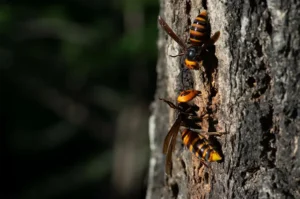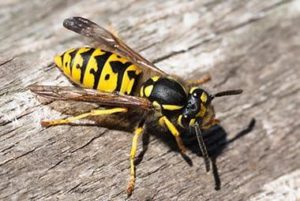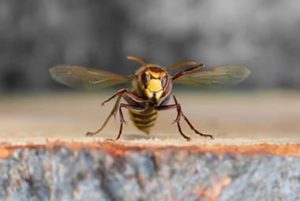Knoxville, Maryville, Lenoir City, and many other parts of the greater Knoxville area took a beating from the recent storms. Our thoughts are with our neighbors, and we hope that the cleanup work is coming along. We thought that, since many people are doing work around their houses, our readers might appreciate information about a pest that can be treated with some simple home repair work. Today, let’s look at carpenter bees.
Carpenter bees are very large, and they have the unpleasant habit of hovering near their nest sites and chasing anyone who comes too close. You probably started to notice them zinging by your head in mid-March when the weather started to warm up. Still, they are rarely aggressive and will only sting if threatened. Unlike their bumble bee cousins, carpenter bees are not hive creatures. They build solitary nests by drilling through wood and creating a cavity in which eggs and larvae are protected. These bees do not eat the wood as termites do, so a common indicator of carpenter bees is small piles of sawdust on your back deck or on the porch below your wood siding.
If you want to treat for carpenter bees, here are some tips to consider. Using an over-the-counter product in the holes is a start, but it won’t eliminate your problem. If possible, use a flashlight and treat the holes at night when the bees are inactive. If that idea is not practical in your case, bring a spray can with a product that you can use to knock down and kill the adults so you don’t get stung while you work (I have a friend who uses a wiffle ball bat for this portion of the work, but I don’t recommend it). Then, use a product that leaves a residue in the holes so that your treatment lasts longer. Remember, most of the spray cans for bees and wasps are only for immediate contact use; they will kill a bee that you spray but will not leave lasting protection against the bees. Many over-the-counter products are labeled to last up to three months, and you’d be better off trying one of those in the holes. Always use products that are labeled for the pests you’re treating, and only use them in ways that the label allows. Also, remember to position yourself carefully if you’re treating high places; you don’t want the product that you use to fall back down on you while you work.
Treat the holes in early spring and again in summer to make sure you’ve contacted all the bees with the product. Then, in the fall, fill the holes with wood putty. The bees won’t want to chew through the putty and will not be able to re-use the same holes. Finally, if you are doing some home repairs in the coming weeks, we recommend that you put a coat of paint or varnish on the affected wood. Pressure-treated wood is still vulnerable to carpenter bee attack, but a coat of paint will frustrate a bee’s chewing efforts and may make it think twice about sharing living space with you.
We get many calls about carpenter bees because they can be tough to treat. Their nests are often hard to reach, so many homeowner’s don’t want to deal with the trouble. At Russell’s Pest Control, carpenter bee treatments are done with a large sprayer or blower that can more easily reach the affected areas to alleviate the problem. Sound like a service you could use? You know where to find us, and you can always call us for more information.
Carpenter Bee Identification in Knoxville TN
Serving East Tennessee since 1971


